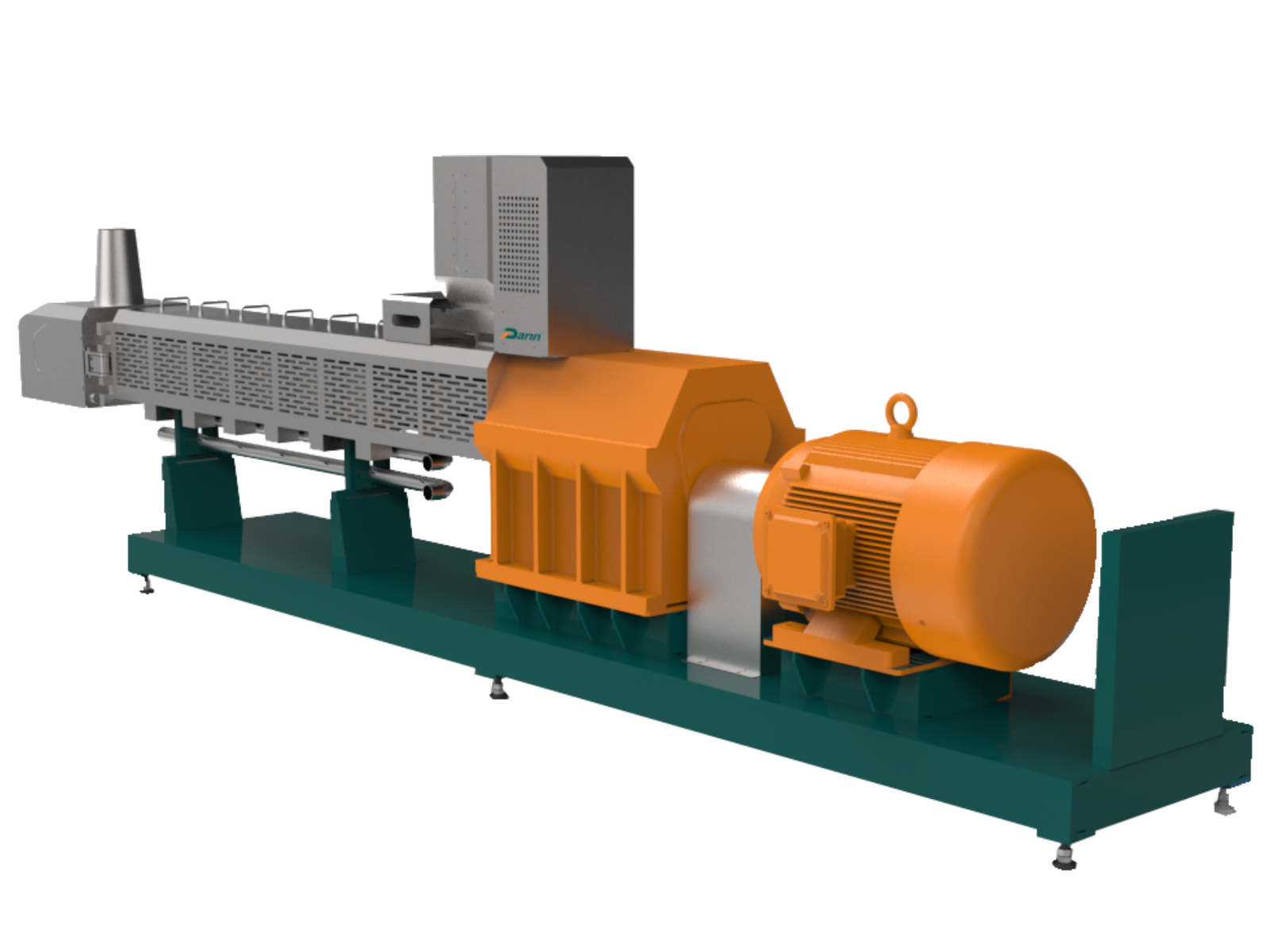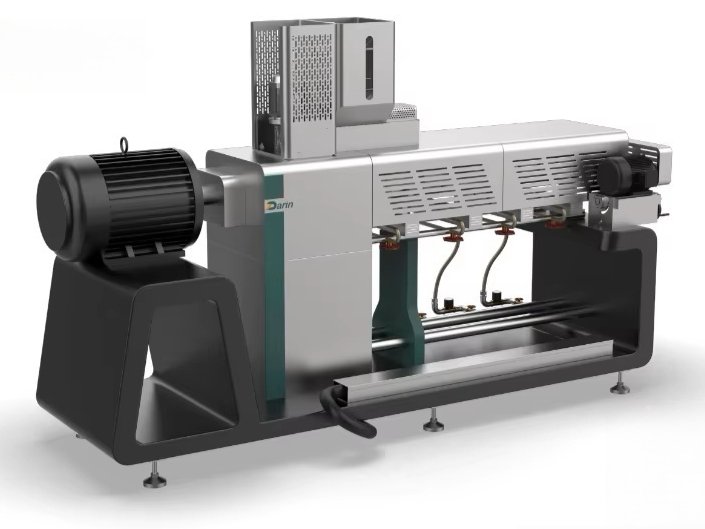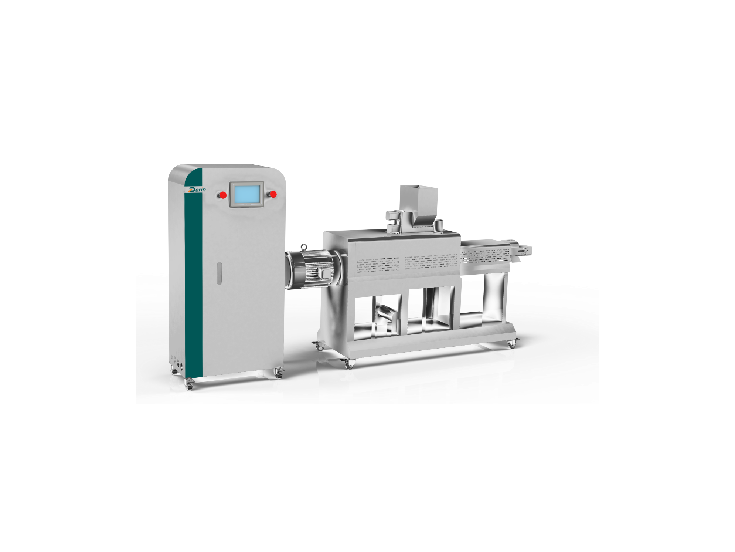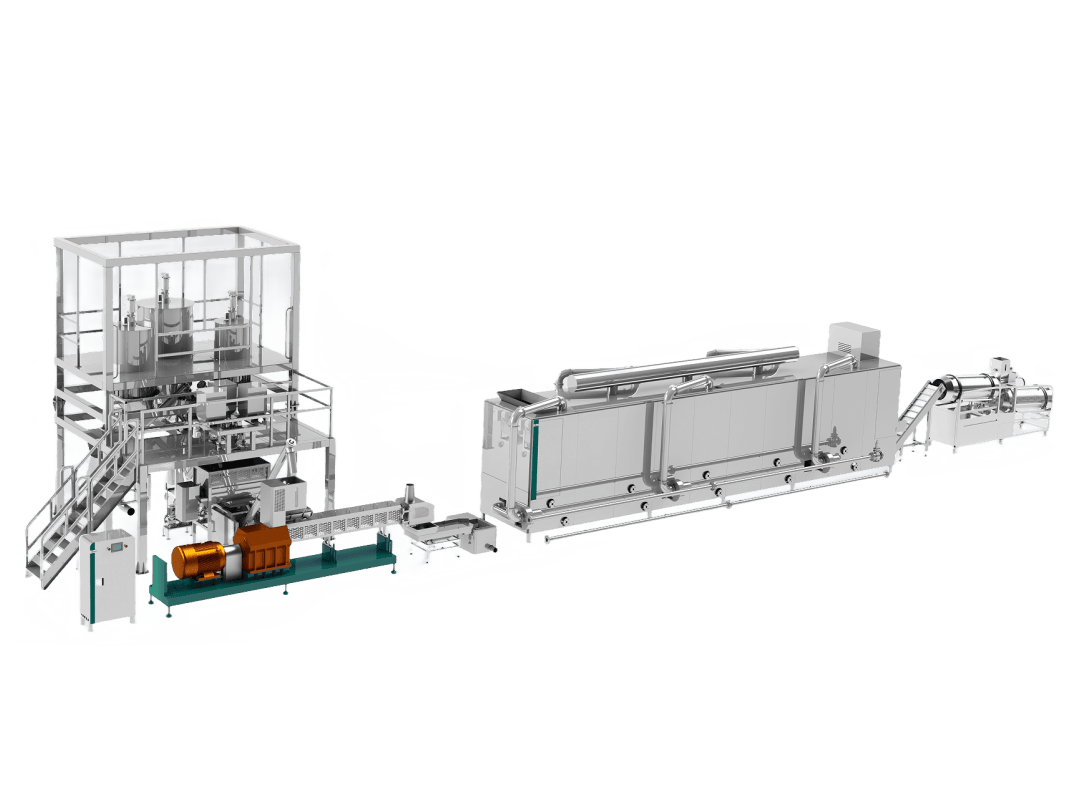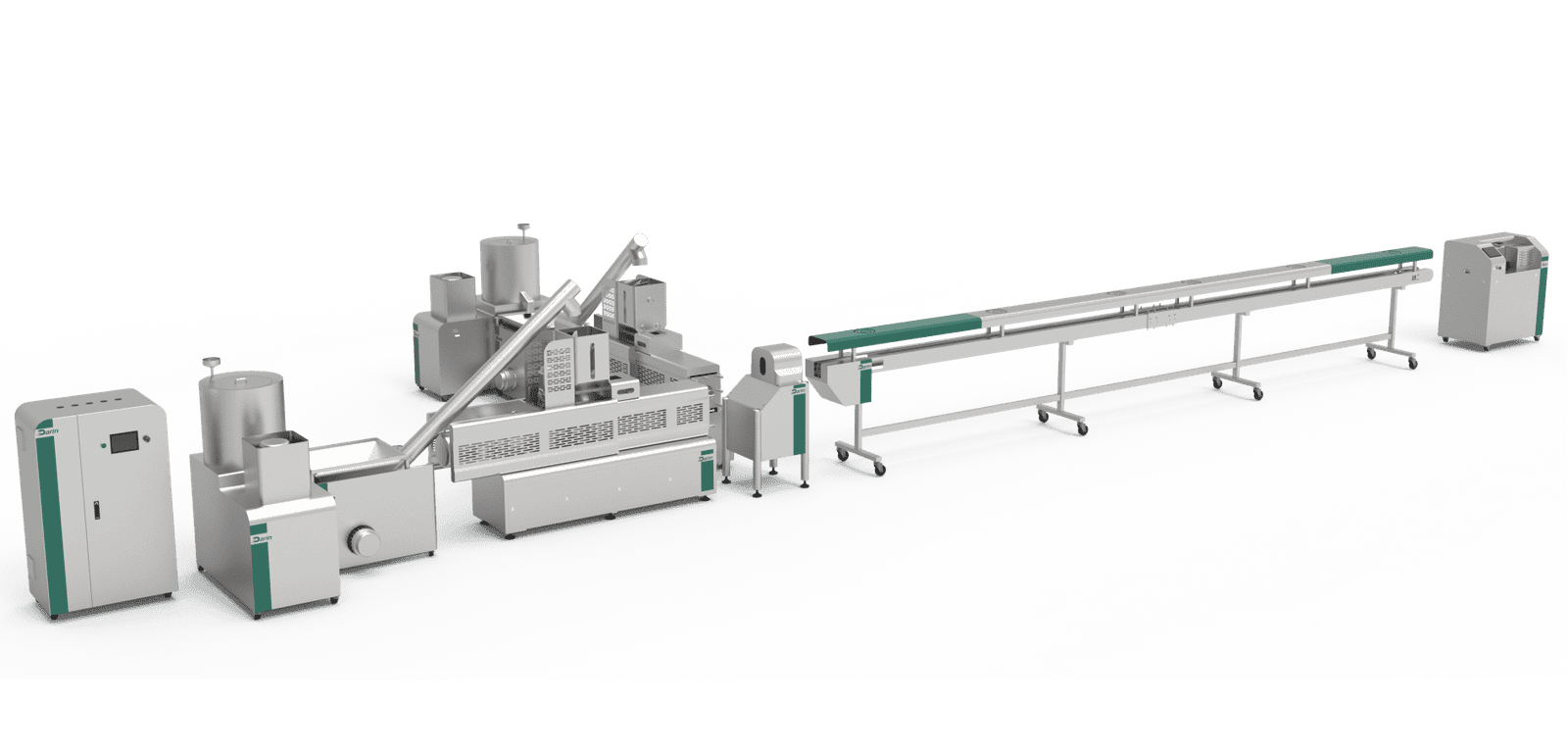
Ever wondered what goes into making your furry friend's favorite meals?
The primary machines used to make dog food include extruders, mixers, grinders, dryers, and packaging machines. These machines work together to process raw ingredients into finished products like dry kibble, canned food, and treats.
When I first stepped into the world of pet food manufacturing, I was blown away by the sheer scale and complexity of the machinery involved. Each piece of equipment plays a vital role, from mixing raw ingredients to perfecting that crunchy kibble texture my dogs love. It's like orchestrating a symphony where each machine is a crucial instrument in crafting nutritious meals for pets around the globe. Let me take you through how these marvels of engineering ensure our furry companions get only the best.
Extruders are used to shape dog food kibble.True
Extruders shape and cook the mixture into kibble through pressure and heat.
Mixers are used for packaging dog food.False
Mixers blend ingredients; packaging machines handle the packing process.
How Does an Extruder Work in Dog Food Production?
Have you ever paused to wonder about the journey your dog’s kibble takes before it ends up in their bowl?
An extruder in dog food production combines ingredients, cooks them through heat and pressure, and shapes them into kibble. It ensures uniformity, enhances digestibility, and adds necessary nutrients to the final product.

The Basics of Extrusion
Let me tell you, watching raw ingredients transform into perfectly shaped kibble is like witnessing magic in motion. It all starts with extrusion—a process where we mix, cook, and shape ingredients using a sophisticated machine called an extruder. Imagine feeding a bunch of raw materials into a chamber where they are subjected to high pressure and heat. This not only cooks and sterilizes them but makes sure the final product is safe for our beloved pets.
Components of an Extruder
Breaking down the extruder is like dissecting an art project—each piece has a role to play:
- Feeding System: Think of it as a buffet line where ingredients queue up to enter the action.
- Barrel: This is the heart of the operation, where mixing and cooking happen.
- Screw: A rotating marvel that drives the whole process, generating just the right amount of friction and heat.
- Die: This is where the magic happens—shaping the mixture into those adorable little pieces our pets love.
| Component | Function |
|---|---|
| Feeding System | Introduces ingredients |
| Barrel | Mixes and cooks |
| Screw | Generates heat and pressure |
| Die | Shapes the final product |
Benefits of Using an Extruder
- Consistency: It’s like making sure every cookie in a batch is identical—extruders guarantee uniform size and shape.
- Nutrient Retention: Ever tried to cook a meal where you keep all the good stuff intact? Extrusion does just that for dog food, preserving essential nutrients to make it more nutritious1.
- Enhanced Digestibility: Imagine breaking down tough veggies for a stew—that’s what pressure cooking does for starches and proteins, making them easier for dogs to digest.
The Role of Heat and Pressure
Heat and pressure aren’t just about cooking; they transform ingredients, creating expanded textures that dogs find easy to chew. Plus, by controlling temperature, we can retain or even enhance flavors, often adding tasty coatings post-extrusion for that extra yum factor.
Quality Control in Extrusion
Ensuring quality in extrusion is like keeping an eye on every dish coming out of a kitchen. We closely monitor moisture content, density, and cooking time to meet safety standards. With sophisticated sensors and monitoring systems, consistency is maintained across all production batches.
The extrusion process is integral in producing high-quality dog food that is safe, nutritious, and palatable for pets. By understanding how it works, manufacturers can optimize production to meet consumer demands for premium pet nutrition2.
Extrusion cooks ingredients at low temperatures.False
Extrusion involves high pressure and temperature to cook ingredients.
The die shapes the final product in extrusion.True
The die at the end of the barrel shapes the mixture into kibble.
How Do Mixers Enhance Dog Food Manufacturing?
Ever wonder what goes into making your dog's food consistently delicious and nutritious?
Mixers in dog food manufacturing are essential for blending various ingredients uniformly, ensuring consistency and nutritional value. They play a pivotal role in combining wet and dry components to create a balanced product.

How Mixers Ensure Consistency and Quality
You know how, when you're baking, getting the perfect blend of ingredients can make or break the end result? Well, mixers in dog food manufacturing are like those trusty kitchen appliances but on a grander scale. They're the unsung heroes that ensure every scoop of kibble or morsel of wet food is bursting with balanced nutrition. Imagine having to mix meats3, grains, vitamins, and minerals all by hand—that's where these incredible machines step in to save the day!
Mixing Techniques:
- Batch Mixing: It's like preparing a family-sized meal, where you have the freedom to tweak each batch to perfection. This method is perfect for smaller operations that need precision.
- Continuous Mixing: Now, this is for when you're feeding an army! It's all about efficiency, constantly churning out product without missing a beat, ideal for those big manufacturers keeping up with high demand.
Types of Mixers Used
Choosing the right mixer is like picking the right tool for a job—it can change everything about how the final product turns out. Here's a peek at two types we often use:
| Type | Features | Application |
|---|---|---|
| Ribbon Mixers | Provide gentle, thorough blending. | Suitable for dry pet food production. |
| Paddle Mixers | Offer more aggressive mixing for dense materials. | Often used for wet or semi-moist food. |
Benefits of Using Advanced Mixing Technology
I remember the excitement of getting our first advanced mixer—it's like upgrading from a flip phone to the latest smartphone! These modern marvels can fine-tune speed, temperature, and time, offering us the flexibility to craft pet food that fits every dietary need imaginable.
The Impact on Nutritional Value
It's not just about taste; it's about ensuring every bite is packed with the promised health benefits. Proper mixing means no nutritional stone is left unturned, crucial for keeping our furry friends happy and healthy.
By understanding these facets of mixing technology, I can help manufacturers fine-tune their processes, ensuring that every dog food product not only meets industry standards but also exceeds consumer expectations.
Explore different mixer technologies4 to find the right fit for your production needs.
Mixers ensure even distribution of dog food ingredients.True
Mixers blend ingredients like grains and vitamins uniformly to maintain consistency.
Ribbon mixers are used for wet dog food production.False
Ribbon mixers are typically used for dry pet food, not wet or semi-moist.
Why Are Dryers Essential in Making Dry Dog Food?
I once marveled at how a simple machine could revolutionize the way we feed our pets.
Dryers are essential in dry dog food production because they effectively remove moisture, preventing bacterial growth and spoilage while preserving nutritional value and flavor. This process ensures a longer shelf life and maintains food quality.

The Role of Dryers in Moisture Removal
I remember the first time I saw a dryer in action—it was like watching magic unfold. The way it methodically removed moisture from each piece of kibble was mesmerizing. This isn't just about drying the food; it's about safeguarding it against potential harm. Moisture might seem harmless, but when left unchecked, it can quickly turn a bag of kibble into a breeding ground for bacteria. I've seen firsthand how dryers step in as unsung heroes, ensuring every batch is safe and stable.
A standard drying process involves several steps:
| Step | Description |
|---|---|
| Initial Heat | Food is exposed to high temperatures to evaporate water. |
| Air Flow | Fans circulate hot air to ensure even moisture removal. |
| Cooling | Food is cooled to stabilize before packaging. |
These steps are vital in creating a stable and safe pet food environment5.
Preservation of Nutritional Value and Flavor
Have you ever opened a bag of dog food and wondered about the aroma that seems to captivate your furry friend instantly? That's where the drying process works its wonders. By effectively locking in nutrients and enhancing flavors, dryers make sure that every bite is as nutritious as it is delicious. I once had a pet who was an incredibly picky eater, but once I switched to properly dried kibble, there was no turning back.
A well-dried piece of kibble maintains the perfect balance of protein, carbohydrates, and fats, making sure your pet receives all the nutrients it needs. Discover more about how nutrients are preserved through drying by exploring nutritional benefits of drying6.
Importance for Shelf Life Extension
Buying in bulk has its perks—until you start worrying about spoilage. Thanks to dryers, though, pet owners can stock up without fear. By removing moisture, these machines extend the shelf life of dog food significantly. This not only saves money but also provides peace of mind, knowing your pet's food will remain fresh and safe.
The following table outlines how moisture content affects shelf life:
| Moisture Content | Shelf Life |
|---|---|
| High (15%+) | Short (Weeks) |
| Optimal (5-10%) | Long (Months/Years) |
Ensuring optimal moisture levels through effective drying processes like these guarantees that your pet's food stays fresh longer. For more detailed insights on shelf life management7, be sure to check relevant resources.
Understanding the critical role dryers play helps us appreciate the complexity behind producing safe and nutritious dry dog food. From extending shelf life to preserving flavor and nutrients, these machines are indispensable in modern pet food production.
Dryers prevent bacterial growth in dry dog food.True
By removing moisture, dryers inhibit conditions that favor bacterial growth.
High moisture content extends dry dog food shelf life.False
High moisture promotes spoilage, reducing shelf life; drying extends it.
How is quality control maintained with dog food machinery?
Ever wondered how the kibble your furry friend loves stays consistently safe and tasty?
Quality control in dog food machinery involves stringent checks, automated monitoring, and compliance with international standards. Advanced sensors and robotics ensure consistent product quality by detecting anomalies in production.

Key Components of Quality Control in Dog Food Machinery
Let me take you on a journey through the heart of our pet food production process. Imagine this: I’m watching our advanced machinery at work, a dance of gears and precision that ensures every morsel is just right. At the core of this symphony are several vital components that guarantee quality:
Automated Monitoring Systems: Picture sensors and cameras tirelessly scanning every stage of production. They’re like vigilant guardians, spotting even the slightest hiccup in ingredient mixing or temperature. It's like having an extra set of eyes everywhere.
Standard Compliance: With our machines aligned with international standards like CE and ISO 9001, it feels like we're part of a global club of excellence. This adherence means our machinery can strut its stuff on any stage worldwide while maintaining top-notch quality.
Regular Maintenance Protocols: Here’s a personal note—I’ve learned that keeping machines in tip-top shape is just like regular health check-ups. We schedule maintenance religiously to prevent any surprises that might disrupt the quality we’re known for.
Advanced Technology in Dog Food Machinery
Incorporating cutting-edge technology is like adding a secret ingredient to our recipe for quality control:
Robotic Automation: Imagine robots delicately handling ingredient measurements and mixing. They reduce human error and ensure that each batch is consistently perfect—it's like having an expert chef overseeing every step.
Real-time Data Analytics: I love how data becomes our best friend here. We analyze production processes in real-time, allowing us to make informed decisions quickly, enhancing efficiency, and ensuring our final product's integrity.
A Quick Glance at Quality Assurance Technologies
| Technology | Functionality |
|---|---|
| Automated Sensors | Detect inconsistencies in texture and ingredient ratios |
| Real-time Analytics | Provides data insights for immediate decision-making |
| Robotics | Ensures precision in mixing and packaging |
Continuous Improvement and Innovation
I’m passionate about keeping us ahead of the curve with innovation:
R&D Investments: By continuously investing in research and development, we keep pushing boundaries, discovering new ways to enhance quality control processes.
Feedback Mechanisms: I’ve found that listening is key—feedback from our users guides us in refining machinery designs, ensuring we meet their needs more precisely.
Exploring various technological advancements8 aligns with our commitment to stay at the forefront of quality assurance, making sure that every batch meets our high standards.
Industry Partnerships and Certifications
Building partnerships with esteemed brands like General Mills bolsters our credibility. It's like being part of an elite team where shared knowledge and best practices drive overall improvements in quality control processes. This collaboration ensures we remain leaders in the industry.
Automated sensors detect texture inconsistencies.True
Automated sensors are designed to monitor texture and ingredient ratios.
Robotic automation increases human error in production.False
Robotic automation reduces human error by ensuring precise measurements.
What Innovations Are Shaping the Future of Dog Food Production?
Ever wondered what's brewing in the world of dog food? Let me take you on a journey through the latest innovations reshaping this vital industry.
Innovations in dog food production include personalized nutrition, sustainable ingredients, advanced processing technologies, and health-focused formulations. These advancements are reshaping how pet food is produced and meeting the evolving needs of pet owners.

Personalized Nutrition
When I first heard about personalized nutrition for dogs, I was intrigued. Imagine being able to tailor your dog's meals just like a chef preparing a gourmet dish! Companies are now diving deep into data, using AI and machine learning to design diets that consider your dog's breed, age, weight, and even health quirks. I remember talking to a fellow pet parent who shared how their pup's energy levels skyrocketed after switching to a personalized diet. It's like offering a bespoke service for your furry friend, strengthening that unique bond between you two.
For instance, platforms are emerging where pet owners can input their dog's details and receive a personalized nutrition plan. This trend not only enhances health outcomes but also strengthens the bond between pets and their owners by catering to individual needs.
Sustainability in Ingredients
Sustainability has become more than just a buzzword—it's a lifestyle choice, even for our pets. I'm personally excited about the shift towards sustainable ingredients like insect protein and lab-grown meat. These aren't just environmentally friendly; they're a nod towards ethical sourcing. I once met a passionate dog food manufacturer at a trade fair who was zealously sourcing local and organic materials. It's heartening to know that every step taken can make a real difference in reducing our ecological footprint.
Moreover, some companies are focusing on using local and organic ingredients, ensuring traceability and reducing transportation emissions. These initiatives are supported by environmentally conscious consumers who prioritize eco-friendly practices.
Explore more about sustainable ingredients9
Advanced Processing Technologies
You know, I've always been fascinated by the tech behind pet food production. Modern methods like extrusion and freeze-drying have transformed how we think about dog food. Extrusion allows for a variety of textures—think crunchy or soft—and ensures essential nutrients remain intact. I recall touring a facility where freeze-drying was extending shelf life while preserving nutrients. It was amazing to see technology making nutritious options convenient for busy pet owners like myself.
| Technology | Benefits |
|---|---|
| Extrusion | Enhanced texture and nutrient retention |
| Freeze-Drying | Preserved nutrients, extended shelf life |
Learn how extrusion technology works10
Health-Focused Formulations
As someone deeply invested in my dog's health, I'm thrilled about health-focused formulations. These blends incorporate ingredients like probiotics, omega-3s, and antioxidants—each supporting digestion, joint health, or immunity. I once swapped out my dog's regular kibble for a health-focused blend and noticed significant improvements in his coat and energy levels. It's clear that these formulations are more than just a trend; they're part of a holistic approach to pet wellness.
AI analyzes dog profiles for diet recommendations.True
AI is used to analyze pet profiles and recommend personalized diets.
Insect protein reduces dog food's ecological footprint.True
Insect protein is a sustainable alternative, lowering environmental impact.
How Do Packaging Machines Enhance Pet Food Shelf Life?
Imagine the disappointment of opening a bag of pet food only to find it stale or spoiled.
Packaging machines enhance pet food shelf life by using technologies like Modified Atmosphere Packaging (MAP) and vacuum sealing, which reduce oxygen exposure, slow spoilage, and maintain product quality over time.
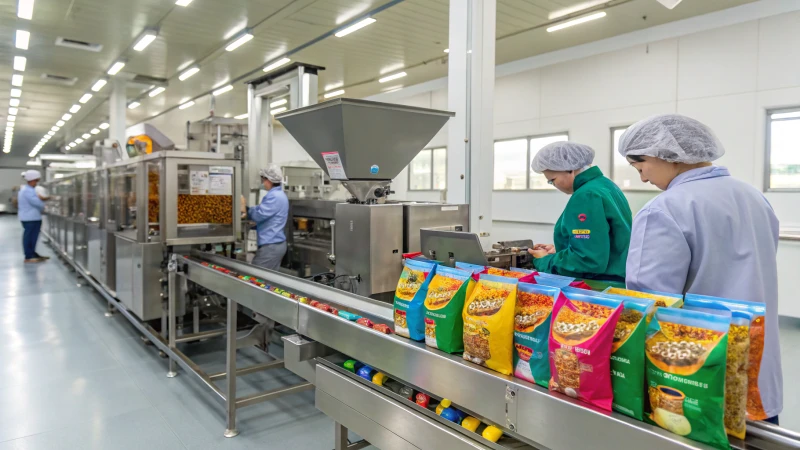
Understanding Packaging Technologies
I remember the first time I walked into a pet food production facility and saw the intricate dance of packaging machines. It was mesmerizing, watching how they used Modified Atmosphere Packaging11. MAP essentially swaps out the air inside the package with a mix of gases like nitrogen and carbon dioxide. This clever trick reduces oxygen, which means less oxidation and microbial growth, keeping the food fresh for our furry friends.
Vacuum Sealing Advantages
There's something satisfying about watching a vacuum sealer in action. It’s like watching a magician pull off a trick, but instead of rabbits from hats, it’s about freshness. Vacuum sealing removes the air from the package, creating an environment that naturally slows spoilage. This method is fantastic for pet foods that might lose moisture or turn rancid if left to their own devices.
| Technology | Purpose |
|---|---|
| MAP | Reduces oxygen, inhibits bacteria |
| Vacuum Sealing | Removes air, prevents spoilage |
Innovations in Packaging Materials
Then there are the materials themselves—kind of like the unsung heroes of packaging. Imagine layers that shield against moisture and oxygen or even offer UV protection. It's fascinating how these multi-layer films can be customized to meet specific needs, extending shelf life further.
Impact on Distribution and Storage
I’ve seen how improved packaging lets pet food travel farther without losing its quality. This means manufacturers can reach international markets with ease, ensuring that even if your pet's food is made halfway across the world, it arrives fresh. Plus, with better shelf life, there’s less waste—a win for both producers and retailers.
Exploring Future Trends
Exciting times are ahead with innovations like edible packaging12. These new approaches not only extend shelf life but also aim to reduce environmental impact. I love thinking about how these advancements might soon change the way we think about packaging in the pet food industry.
Understanding these technologies is like having a backstage pass to see how packaging machines are transforming pet food preservation. Embracing these innovations means ensuring that every bite your pet takes is as fresh as it should be, and that's a mission worth pursuing.
Modified Atmosphere Packaging replaces air with nitrogen.True
MAP uses nitrogen to reduce oxygen, inhibiting oxidation and spoilage.
Vacuum sealing increases oxygen levels in pet food packages.False
Vacuum sealing removes air, creating an anaerobic environment to slow spoilage.
Conclusion
Dog food production involves machines like extruders, mixers, dryers, and packaging systems that ensure quality, consistency, and nutritional value in kibble and treats for pets.
Explore how extrusion retains nutrients essential for your pet's health. ↩
Learn why premium nutrition is vital for your pet's well-being. ↩
Learn about the variety of ingredients blended during the dog food manufacturing process to ensure balanced nutrition. ↩
Find out about the newest innovations in mixer technology that improve efficiency and quality in pet food production. ↩
Learn why controlling moisture is critical in preventing spoilage and ensuring pet food safety. ↩
Discover how drying techniques help maintain nutritional integrity in dog food. ↩
Understand various techniques used to extend the shelf life of pet food products. ↩
Discovering these advancements helps manufacturers keep up with industry trends and improve their quality control measures. ↩
Discover how sustainable ingredients reduce environmental impact and meet ethical standards in dog food production. ↩
Understand how extrusion technology enhances dog food quality by improving texture and nutrient retention. ↩
Learn how MAP works to preserve food by modifying the internal atmosphere of packaging. ↩
Explore how edible packaging reduces waste while protecting food. ↩


